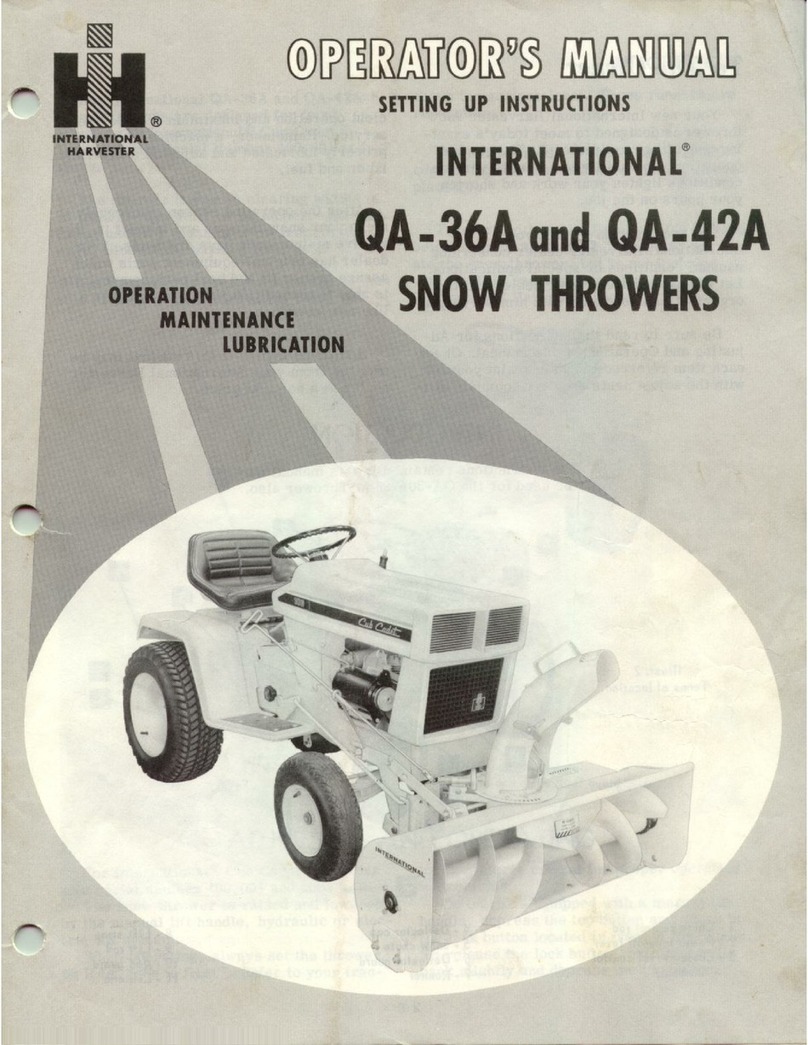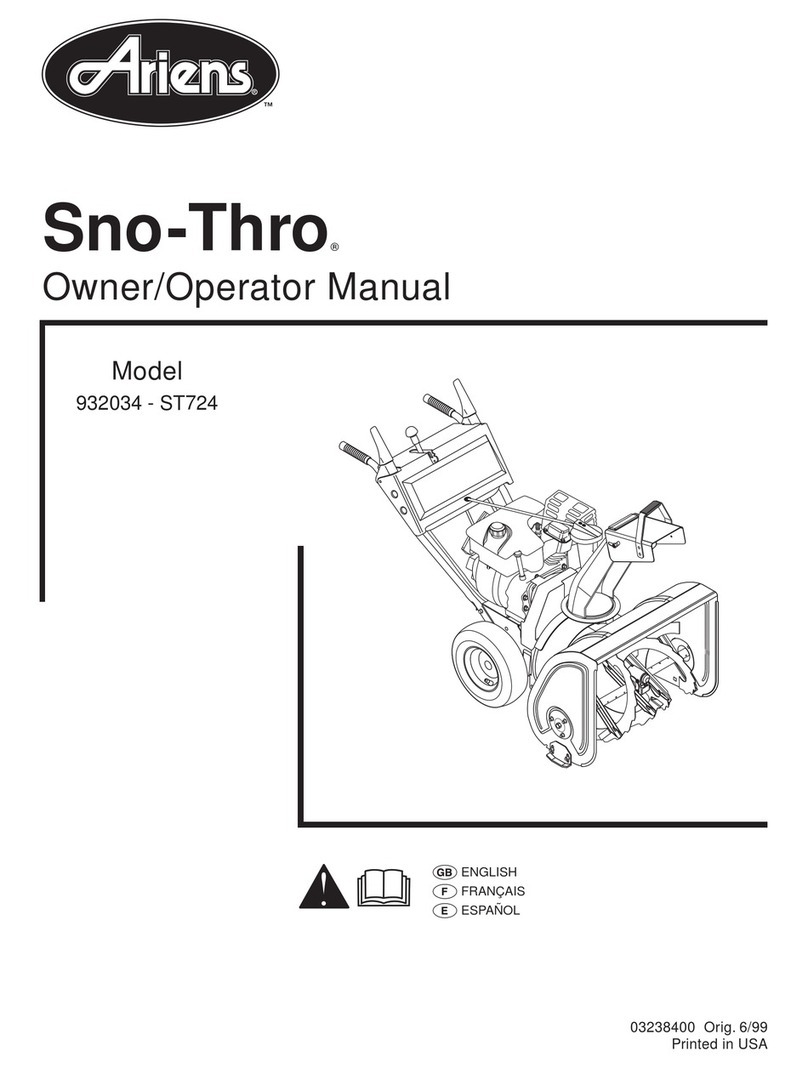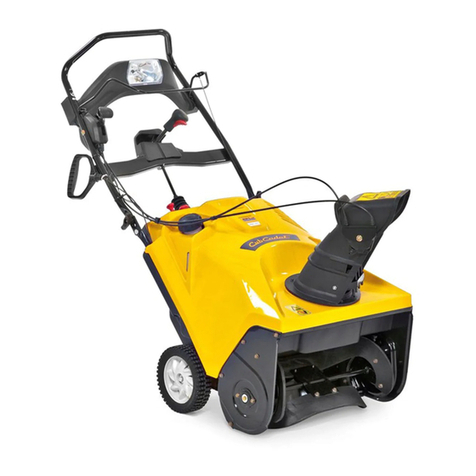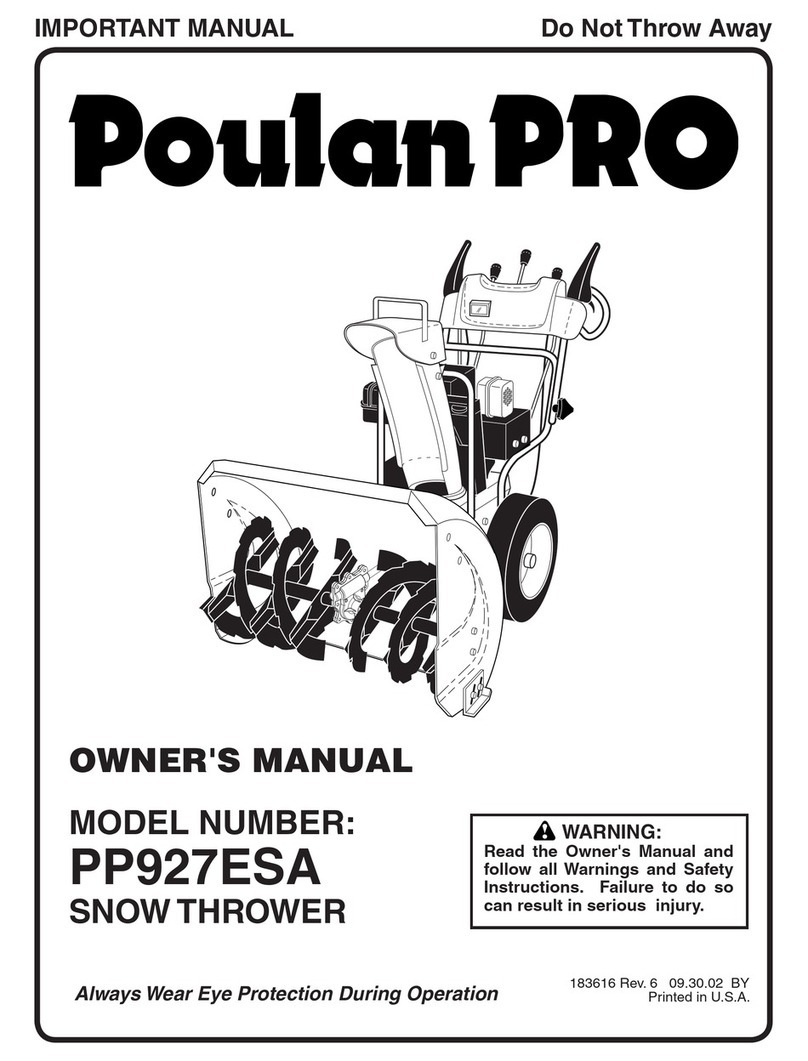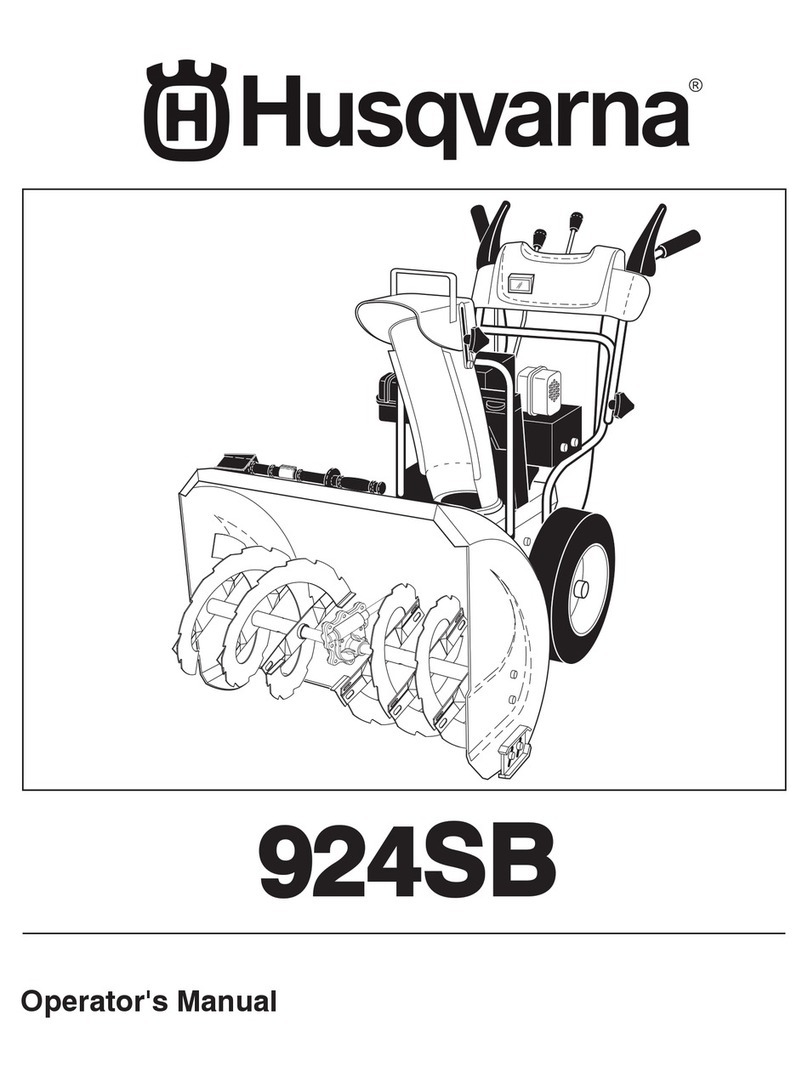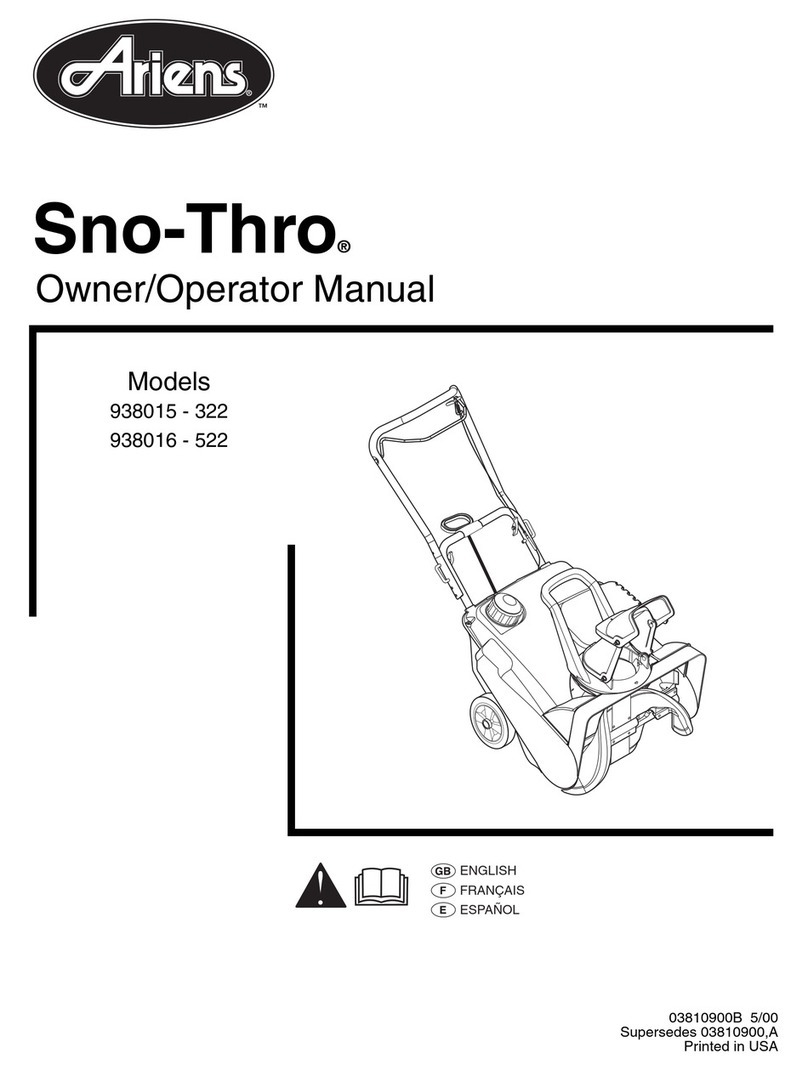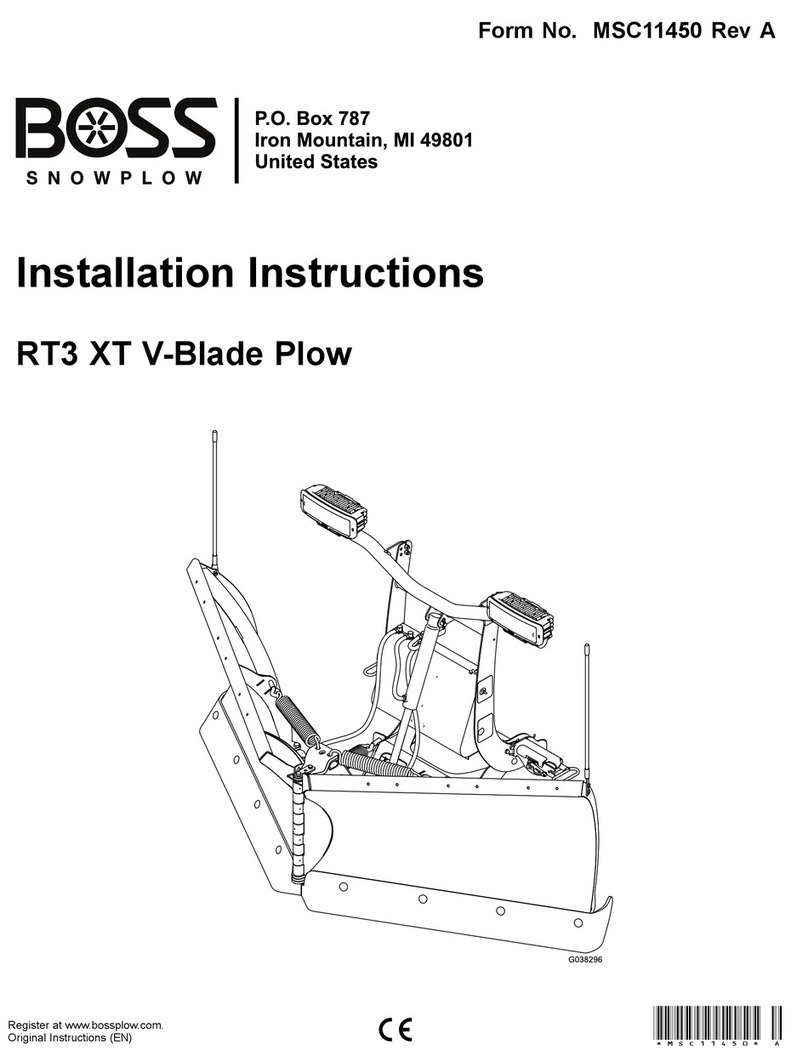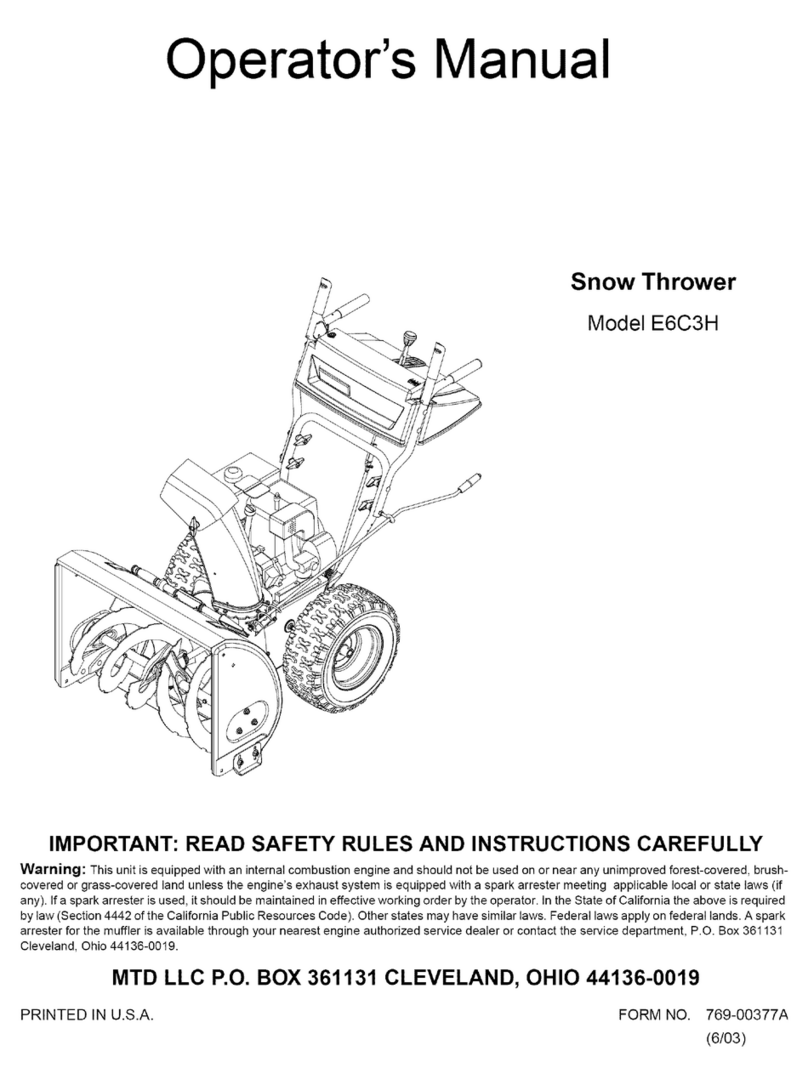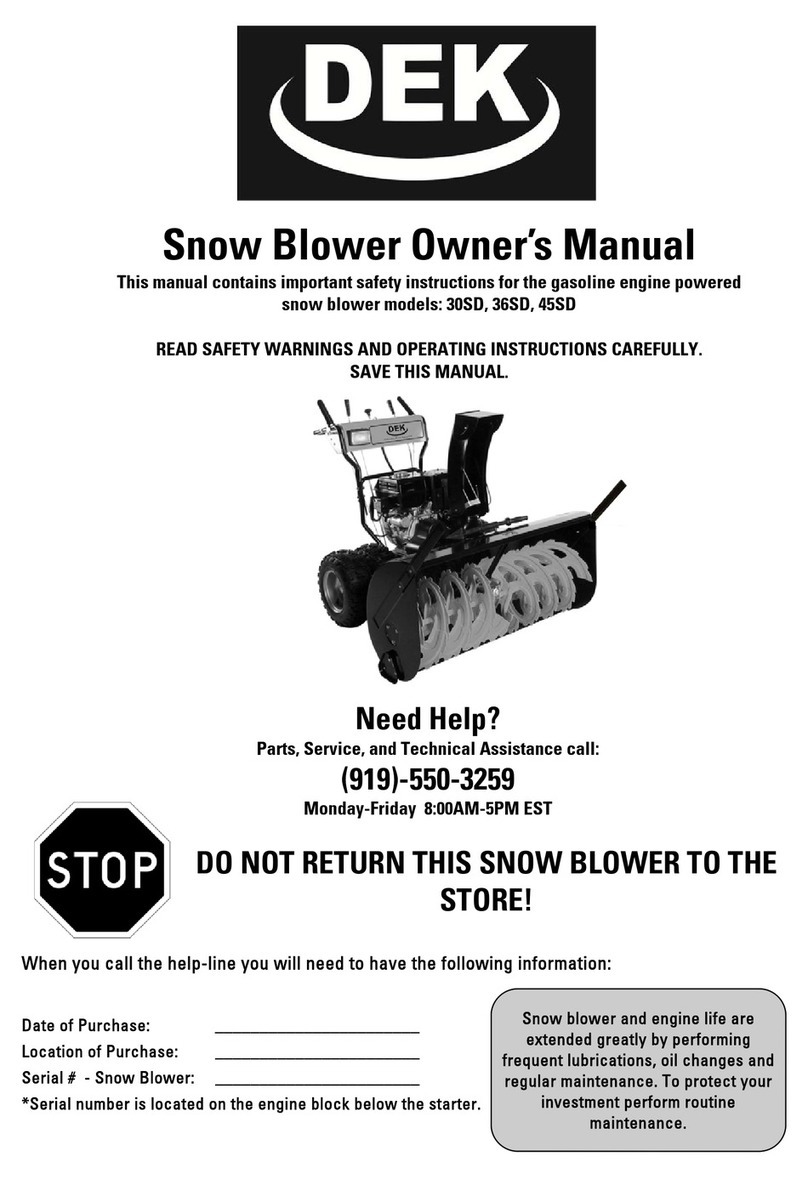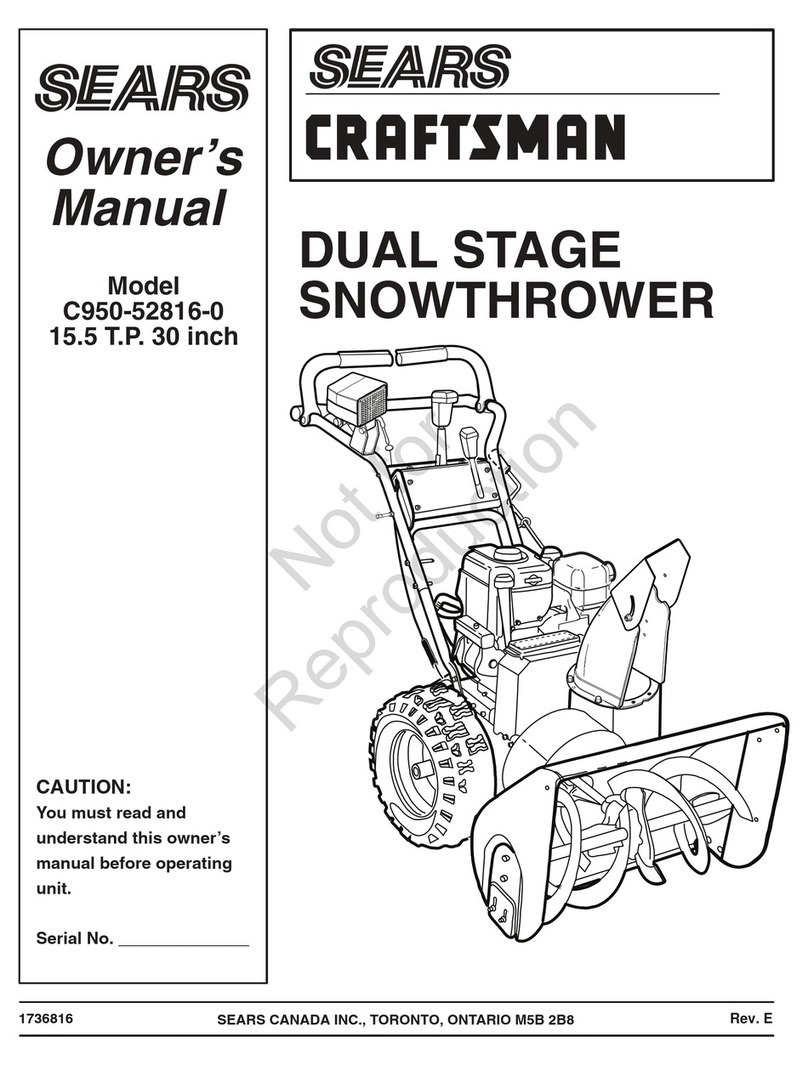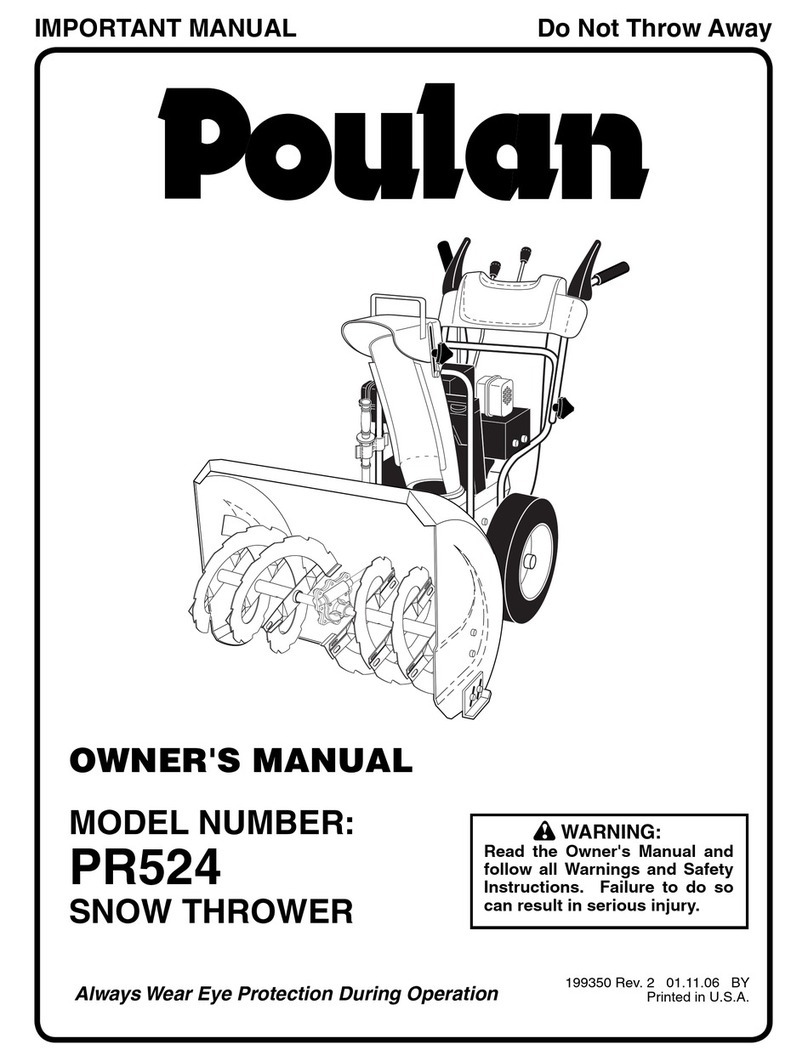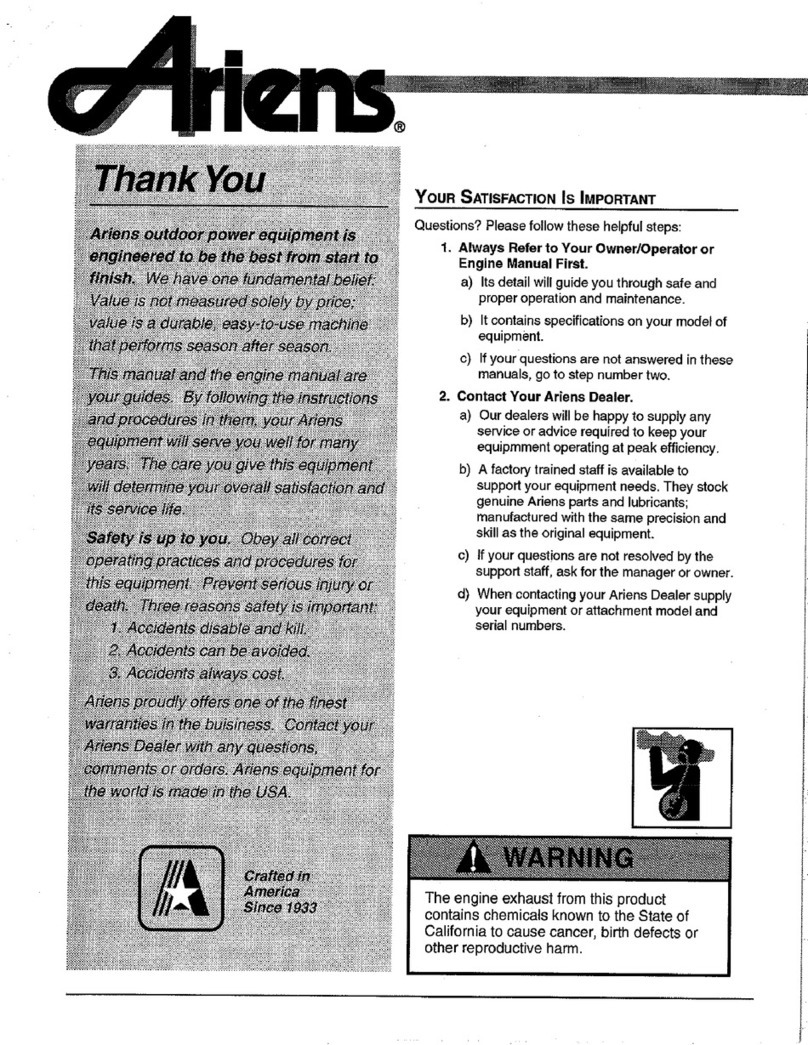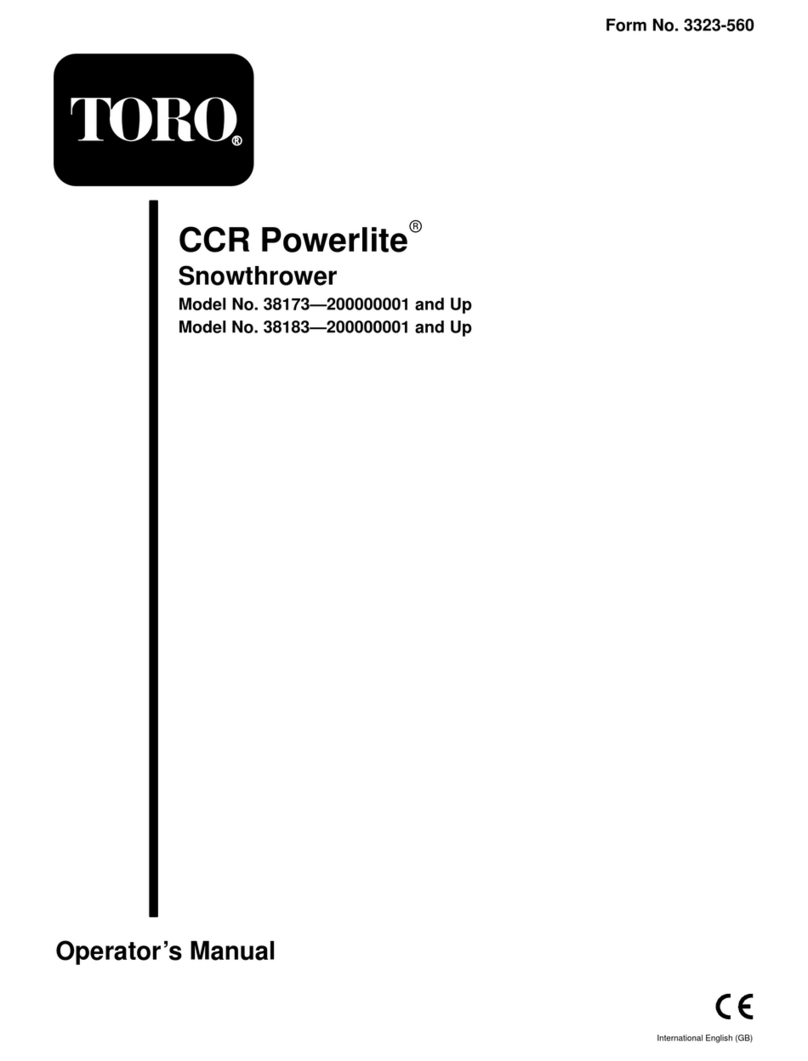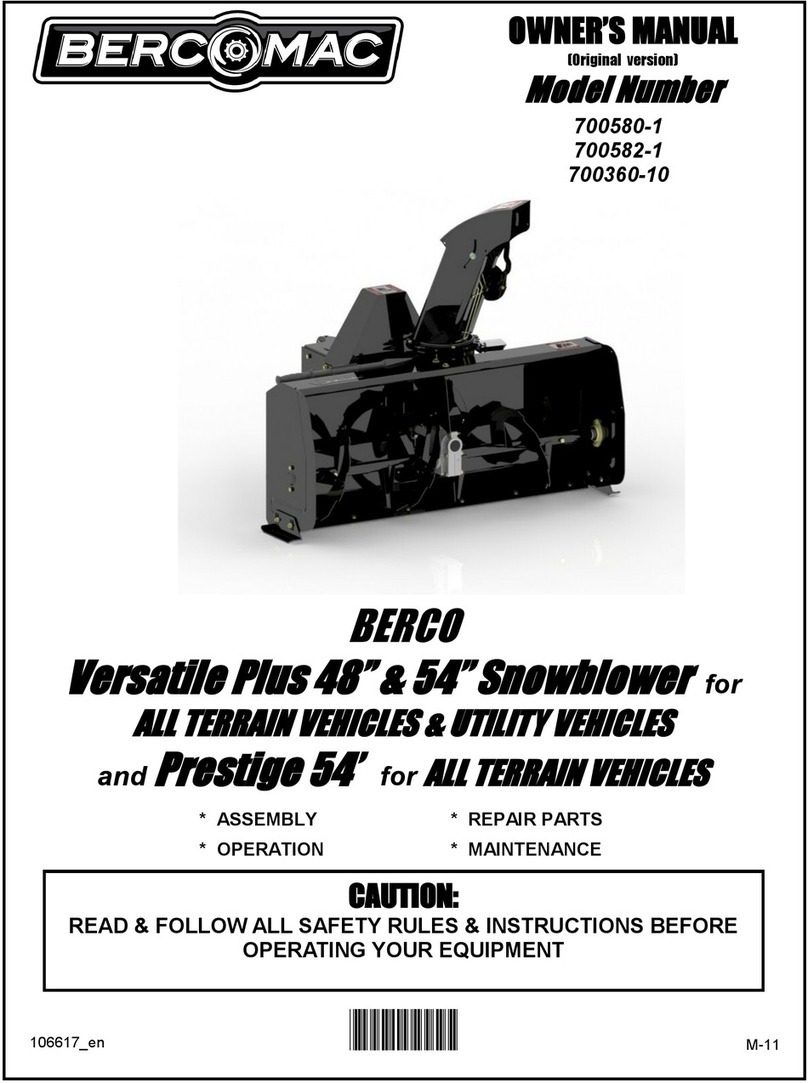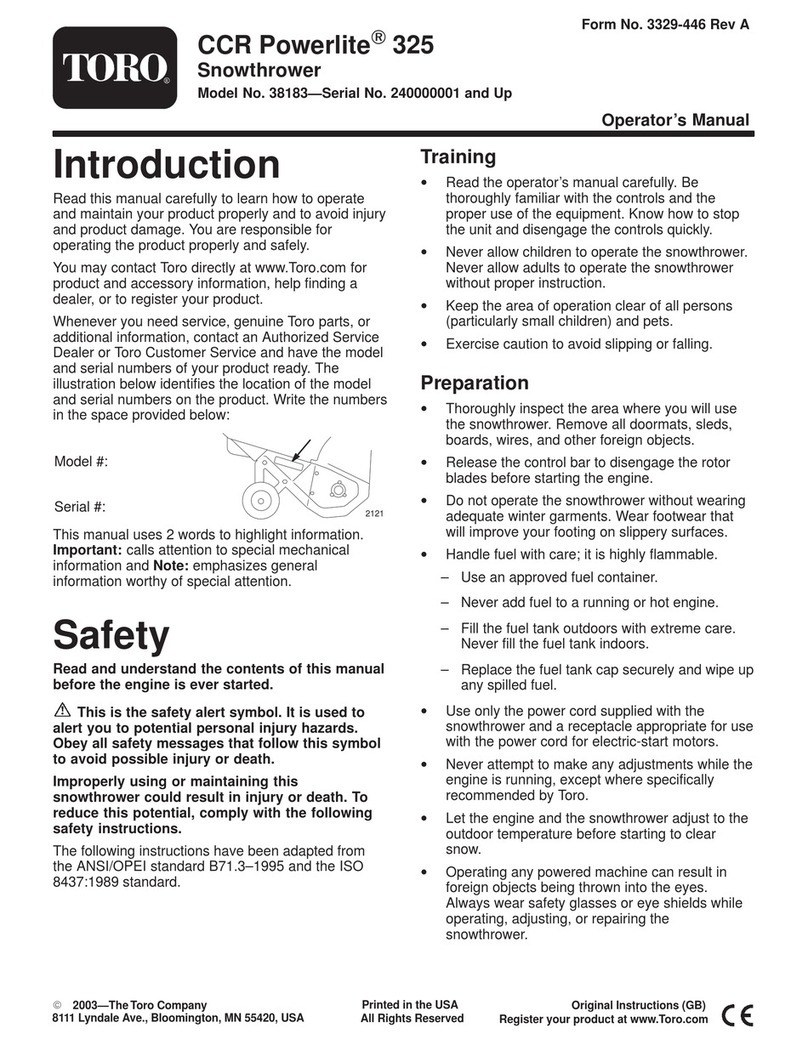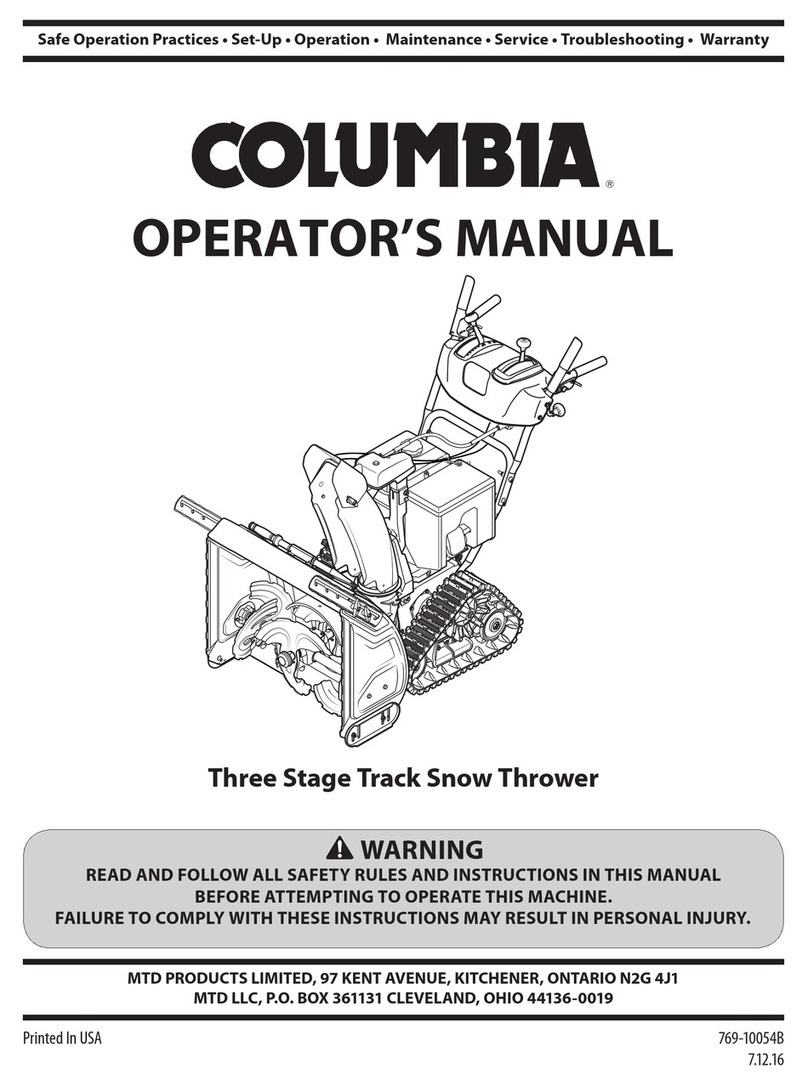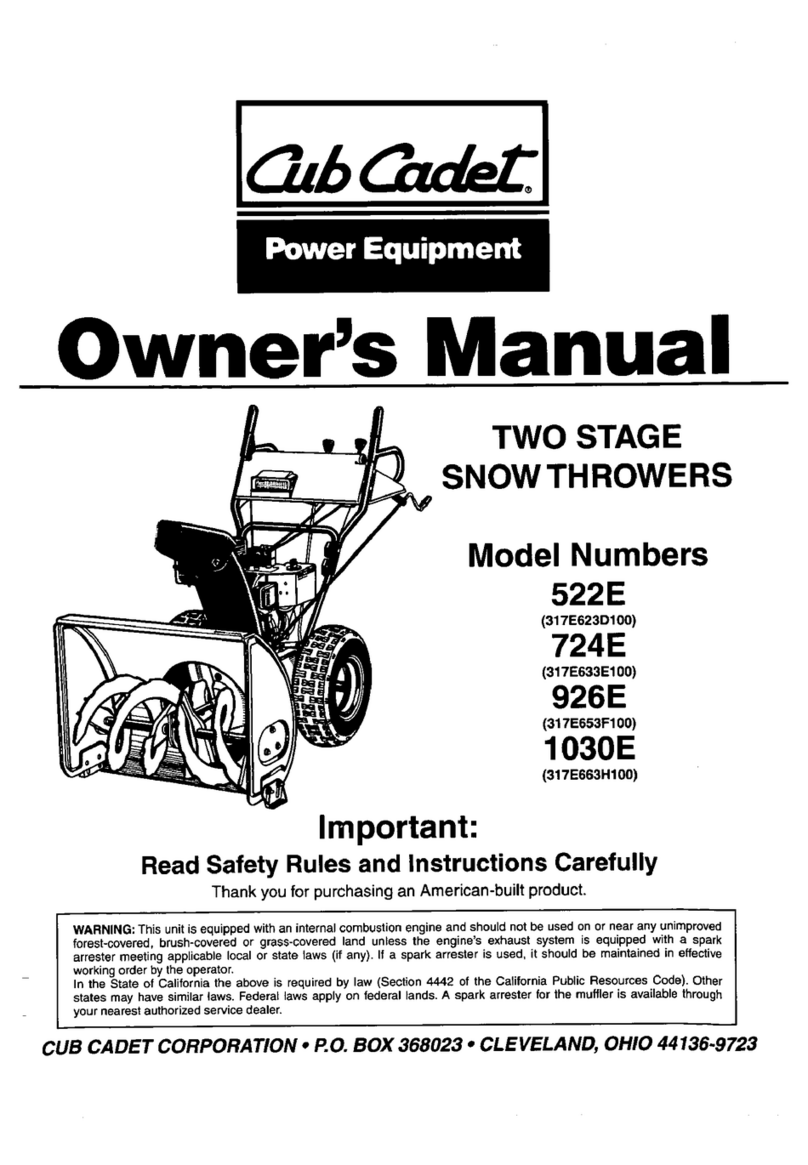International Harvester Company H36 User manual





WORK SAFELY -FOLLOW THESE RULES
Care should be exercised to provide the prop-
er chute direction and deflector cap adjust-
ment to avoid throwing snow and possible
foreign material at people, pets, autos, win-dows,
etc. to avoid injury or damage.
Watch
out for traffic when near or crossingroadways.
Keep machine in good operating condition
and keep safety devices in place.
Keep hands and feet away from front of
machine or discharge chute while tractor
engine is running. Before dismounting tractor
to make any repairs or adjustments or to clear
the rotor/collector, or discharge chute, shifttransmission
to neutral, set park brake, turn
off power take-off and stop engine. Wait for all
moving parts to stop.
Use guards or shields as instructed.
Stop snow thrower, shut off engine and
inspect for damage after striking an object.
Repair any damage before restarting and
operating machine because broken pieces
could be thrown causing injury.
If the machine starts to vibrate shut off the
tractor engine at once and check for loose
mounting bolts, damaged parts or othercause.
Repair if necessary before restarting
and operating.
Look behind tractor before backing. Children
may run up unnoticed behind a tractor.
Avoid overturns -Do not clear snow across
the face of slopes. Exercise extreme caution
when changing direction on slopes. Do not
attempt to clear steep slopes. Do not overload the machine capacity by
attempting to clear the snow at too fast a rate.
Take the time to do the job in a safe manner.
Never operate tractor at high transport
speeds on slippery surfaces. Operate the
tractor smoothly -avoid erratic operation
and excessive speed. Always maintain con-trol.
Never operate the snow thrower without good
light or visibility.
Do not run the engine in confined areas such
as storage buildings any longer than is nec-essary.
Move the tractor outside into the air.
EXHAUST GASES ARE TOXIC. Opening
doors and windows may not provide adequateventilation.
Adjust the snow thrower runner height so that
the thrower housing will clear gravel or
crushed rock surfaces, to prevent the dis-
charge of stones from the snow chute.
No person should be allowed near the work-
ing area when the snow thrower is beingoperated.
No one should operate the machine while
intoxicated or while taking medication that
impairs the senses or reactions.
Check overhead clearance carefully before
driving under low hanging tree branches, or
other situations where the operator may be
struck or pulled from the tractor.
To reduce the possibility of unattended move-
ment of the tractor or its use by unauthorized
operators which could result in an accident
and injury, always turn off the power take-off,
shift transmission into neutral, set the parking
brake, stop the engine, and remove ignition
key when leaving the machine unattended.
AFTER OPERATING
Disengage power to rotor/collector when
transporting or not in use.
Lower equipment to ground before leaving
tractor to avoid the possibility of the equip-
ment dropping and causing injury.
3


GENERAL
The snow thrower controls are conveniently
located at the operator's position. By engag-
ing the P.T.G. clutch, snow is thrown through
the discharge chute by the motion of the
rotor/collector. Turning the discharge chute
control rod directs snow discharge and the
angle of the deflector cap controls the dis-tance
snow is thrown.
top layers first, keeping tractor out of snow
bank where snow has not been removed to
ground level.
Disengage tractor clutch and allow thrower to
clear the snow. Reverse tractor and lower
thrower to the ground. Drive tractor ahead
and repeat process to remove balance ofsnow.
To become familiar with the snow thrower
controls, operate the tractor and snow
thrower in a clear area before attempting to
remove snow.
Working with repeated passes into and out of
drifts will move even the deepest of snowpiles.
Operating Tips
Whenever possible discharge snow downwind.
Snow Conditions Do not attempt to remove ice or hard packed
frozen snow.
Always overlap each pass slightly to assure
complete snow removal.
Never attempt to clear snow thrower at any
time with tractor engine running.
Methods of Operating
Snow removal conditions vary so greatly from
the first light fluffy snowfall to wet heavy snow
that operating instructions must be flexible to
fit the snow removal encountered. The opera-
tor must adapt the tractor and snow thrower
to depth of snow, wind direction, temperature
and surface conditions.
Operating Speed
The rotor/collector speed is directly related
to engine speed. For maximum snow removal
and discharge maintain high engine A.P.M.
(full throttle). Operate the tractor at a slow
ground speed for safe and efficient snow
removal (Usually 1st gear at full throttle).
Deeper Drifted Snow
A definite pattern of operating is required to
thoroughly clean the snow area. This pattern
will avoid a second removal of snow and avoid
throwing snow in unwanted places.
Where it is possible to throw snow to right and
left, as on a long driveway, it is advantageous
to start in the middle. Work from one end to
the opposite end throwing snow to either side
without changing the direction of discharge
chute.
In deep, drifted or banked snow, it will be nec-
essary to drive the rotor/collector into thesnow,
disengage tractor clutch and allow to
clear the snow. If snow can only be thrown to one side of the
driveway or sidewalk, start on the oppositeside.
At the end of each succeeding pass,
rotate the chute 1800 to continue to throw
snow into the same area.
Repeat this method until a path is cleared. On
the second pass overlap the first enough to
allow the rotor/collector to handle the snow
without repeated clutching and declutching of
the tractor.
In extremely deep snow, raise thrower from
ground and drive ahead into snow to remove
Tire ChainsThe
use of tire chains is recommended for
extra traction.
5

ADJUSTING AND OPERATING
LIFT ASSIST SPRING
1 -Spring anchor chain
2 -Lift assist spring chain anchor bracket
3 -Quick-attachable cotter pin
4 -Lift assist spring
The lift assist spring is hooked to the snow Using the anchor chain handle, pull on the
thrower from on the left side, at the rear of the chain to raise the quick-attachable cotter pin
thrower. up off of the anchor bracket surface. Remove
the quick-attachable cotter pin from the
anchor chain, while holding onto the chain
handle. Allow several chain links to pass
downward through the hole in the anchor
bracket to reduce spring tension or pull
several chain links up through th~ hole in the
anchor bracket to increase spring tension
and replace quick-attachabl~ cotter pin
through a chain link just above the anchor
bracket surface.
The lift spring helps to carry the weight of the
snow thrower and makes raising the machine
into transport position easier.
The amount of tension in the lift assist spring
will cause the scraping action of the thrower
and/or the effort required to raise the snow
thrower to vary.
When the snow thrower is used on rough or
uneven surfaces, less scraping is desired and
more lift spring tension is necessary. Lower the snow thrower to the ground. Check
to see that the lift lever effort, to raise the
snow thrower is as desired and/or the down
pressure of the snow thrower is adequate for
required scraping. If not, repeat above adjust-
ment.
When the snow thrower is used on packed or
hard snow, more scraping is desired and less
lift spring tension IS necessary.
To Adjust Spring Tension
Raise the snow thrower to transport position.
6

ADJUSTINGANDOPERATING
RUNNERS
4 -Runner
5 -Direction of movement to lower housing
6 -Wooden block
1 -Rotor/collector housing
2 -Flange
3 -Direction of movement to raise housing
The snow thrower is shipped with its runners
mounted with the flanges to the inside at the
right and left sides of the rotor/collector
housing.
On a smooth and even surface, such as con-
crete or blacktop, the runners may be
adjusted to allow the rotor/collector to work
close to the ground.
The runners may be removed and reinstalled
with the runner flanges towards the outside to
allow the rotor/collector to operate closer to
the ground surface, if necessary.
To adjust the runners, raise the snow thrower
and place a wooden block or other sturdy
object under each side of the rotor/collector
housing.
The runners maintain the desired distance
above the ground for the rotor/collector hous-
ing when the snow thrower is being operated. Loosen the nuts securing the runners to the
rotor/collector housing and move the runners
to the position required for adequate ground
clearance and retighten the nuts.
When removing snow from an uneven surface
or a gravel path or driveway, the runners
should be adjusted to hold the rotor/collector
housing high above the ground surface. Both runners should be adjusted to the same
height to keep the rotor/collector housing
level.
This will prevent possible damage to the
rotor/collector and keep stones or other
material from being thrown with the snow,
which could result in damage to property or
personal injury. Such adjustment will also
reduce excessive wear on the snow thrower
parts.
Runners are subject to wear due to constant
use and are designed for easy replacement.
Replace before wear is excessive to prevent
possible damage to the rotor/collector hous-
ing.
7

ADJUSTINGANDOPERATING
DISCHARGE CHUTE, DEFLECTOR CAP
AND DRIVE TUBE If the discharge chute tends to rotate and fails
to hold the desired position, make the follow-
ing adjustment.
Tighten the lock nut on the drive tube eyebolt
1/8 turn and check rotation of the drive tube
by turning the discharge chute control rod.
A slight resistance should be noticed. If no
resistance is felt, it may be necessary to
tighten the eyebolt lock nut an additional 1/8
turn.
Tighten the eyebolt lock nut only until the dis-
charge chute holds its position. Do not over-
tighten.
The position of the deflector cap on top of the
discharge chute determines the distance that
snow can be thrown.
To increase the distance that snow is thrown,
move the deflector cap upward. To decrease
the distance, move the deflector cap down-
ward.
Adjustment of the deflector cap cannot be
made from the tractor operator's seat.
A CAUTION! Shut off (disengage)
the P. T .0. (power take-off) clutch
and shut off the tractor engine
before making any adjustment.
1 -Discharge chute control rod
2 -Deflector cap
3 -Discharge chute cable
4 -Discharge chute
5 -Drive tube eyebolt
6 -Drive tube
7 -Eyebolt lock nut
To direct snow from the discharge chute to
the right, turn the discharge chute control rod
to the right (clockwise). To direct the snow
discharge to the left, turn the discharge chute
control rod to the left (counterclock wise). A CAUTION! Never direct dis-
charge of material toward by-
standers nor allow anyone near
the machine while in operation. MA.16652
The discharge chute can rotate within its
limits, a full 270 degrees.
8


ADJUSTINGANDOPERATING
ROTOR/COLLECTOR DRIVE CHAIN
Underside view of rotor/collector housing
showing mounting nuts and drive chain.
1 -Adjusting nuts
2 -Mounting nuts
3 -Jackshaft and sprocket assembly
4 -Rotor/collector drive chain
5 -Rotor/collector housing
1
-Adjusting nuts
10

ADJUSTINGANDOPERATING
ROTOR/COLLECTOR DRIVECHAIN -
Continued
It is important to maintain proper drive chain
tension for maximum chain life. After the first
2 hours of operation and each time the snow
thrower is used thereafter, check drive chain
for proper chain tension.
Too much tension causes wear on the chain
and the bearings. Too little tension may cause
the chain to whip excessively and to jump off
of the sprocket.
1
-Straight edge
2 -Jackshaft sprocket
3 -Rotor/collector drive chain
4 -Rotor/collector sprocket
Slack in the drive chain, due to normal chain
stretch can be removed by adjustment if it
becomes excessive.
To adjust the chain tension, proceed as
follows: Place a straight edge along the drive chain
across the jackshaft sprocket and rotor/col-
lector sprocket.
Loosen the mounting nuts two or three com-
plete turns. Turn the adjustment nuts in or out
until the desired tension is obtained. A deflection of 1/4 to 3/8-inch when hand
pressure is applied to the drive chain indi-
cates the tension is correct.NOTE: Both adjustment nuts must be turnedthe
same number of turns to avoid misalign-
ment of the sprocket with the drive chain. After adjusting the drive chain, check the long
V-belt adjustment guide and adjust if neces-
sary. Refer to instructions under heading of
"LONG V-BELT".
Retighten the mounting nuts to secure thejackshaft.
11

ADJUSTINGANDOPERATING
LONG V-BELT
Correct belt setting
Correct belt setting
7 -Idler pulley bolt head
8 -Idler pulley
9 -Belt adjustment guide
All belts stretch during the first few hours of
operation.
Underside view of rotor/collector
housing and pivot bracket channel Check the long V-belt tension after the first
1/2 hour, then every hour thereafter during
the first five hours of use.
To determine whether long V-belt tension is
correct, check belt adjustment guide located
on the left side of the snow thrower mounting
frame behind the rotor/collector housing.
1
-Rotor/collector housing
2 -Pivot bracket channel
3 -Pivot bracket channel nuts
4 -Inner eyebolt nuts
5 -Outer eyebolt nuts
6 -Eyebolts
12

ADJUSTINGANDOPERATING
LONG V-BELT -Continued
Belt setting too tight
Incorrect belt setting
1 -Rotor/collector housing
2 -Pivot bracket channel
3 -Pivot bracket channel nuts
4 -Inner eyebolt nuts
5 -Outer eyebolt nuts
6 -Eyebolts
7 -Idler pulley bolt head
8 -Idler pulley
9 -Belt adjustment guide
If the idler pulley bolt head on the idler pulley
is above the "RUN" area on the belt adjust-
ment guide, the V-belt tension is too tight and
could result in belt failure.
To keep the rotor/collector housing in align-
ment with the lower mounting frame, turn the
two outer eyebolt nuts (in equal amount of
turns) in a clockwise direction until the idler
pulley bolt head moves to the center "RUN"
area of the belt adjustment guide.
To adjust for the correct belt setting, proceed
as follows: After adjusting the belt tension, the inner
eyebolt nuts should be retightened.
Loosen the four pivot bracket channel nuts
secured to the rotor/collector housing. Retighten the four pivot bracket channel nuts
secured to the rotor/collector housing.
Turn the two inner eyebolt nuts in a clockwise
direction six or seven full turns.
13

ADJUSTINGANDOPERATING
LONG V-BELT -Continued
Belt setting too loose
Incorrect belt setting
1 -Rotor/collector housing
2 -Pivot bracket channel
3 -Pivot bracket channel nuts
4 -Inner eyebolt nuts
5 -Outer eyebolt nuts
6 -Eyebolts
7 -Idler pulley bolt head
8 -Idler pulley
9 -Belt adjustment guide
If the idler pulley bolt head on the idler pulley
is below the "RUN" area on the belt adjust-
ment guide, the V-belt tension is too loose and
could result in belt failure.
To keep the rotor/collector housing in align-
ment with the lower mounting frame, turn the
two inner eyebolt nuts (in equal amount of
turns) in a counterclockwise direction until
the idler pulley bolt head moves to the center
"RUN" area of the belt adjustment guide.
To adjust for the correct belt setting, proceed
as follows: After adjusting the belt tension, the outer
eyebolt nuts should be retightened.
Loosen the four pivot bracket channel nuts
secured to the rotor/collector housing. Retighten the four pivot bracket channel nuts
secured to the rotor/collector housing.
Turn the two outer eyebolt nuts in a coun-
terclockwise directioQ six or seven full turns.
14

ADJUSTINGANDOPERATING
SHORT V-BELT
Belt setting too tight
To adjust for the correct belt setting if the belt
is too tight, proceed as follows:
Loosen the two nuts and the bolt from the
pulley mounting bracket.
Turn the outer nut in a counterclockwise
direction on the belt adjusting bracket. Adjust
the belt to keep it from slipping.
Tighten the inner lock nut on the belt adjust-
ing bracket bolt to "lock in" the correct belt
setting.
Retighten the two nuts and the bolt on the
pulley mounting bracket.
Belt setting too loose
To adjust for the correct belt setting if the belt
is too loose, proceed as follows:
Loosen the two nuts and the bolt from the
pulley mounting bracket.
1 -Upper mounting frame
2 -Belt adjusting bracket bolt
3 -Outer nut
4 -Inner lock nut
5 -Pulley mounting bracket
6 -Pulley mounting bracket bolt
7 -Pulley mounting bracket nuts Loosen the inner lock nut six or seven full
turns on the belt adjusting bracket bolt.
The short V-belt should have enough tensionto
keep it from slipping, but not too much ten-
sion which can result in belt and bearingfailure.
Tighten the outer nut on the belt adjusting
bracket bolt. Adjust the belt to keep it from
slipping.
The short V-belt tension requires a minimum
of adjusting as it is maintained by the clutch
idler pulley.
Retighten the inner lock nut on the belt
adjusting bracket bolt to "lock in" the correctsetting.
Retighten the two nuts and the bolt on the
pulley mounting bracket.
All belts stretch during the first few hours of
operation. NOTE: After the short V-belt has beenadjusted,
check the long V-belt adjustment
guide and adjust if necessary. Refer to
instructions under heading "LONG V-BELT".
Check the short V-belt tension after the first
1/2 hour, then every hour thereafter during
the first five hours of use.
15



Table of contents
Other International Harvester Company Snow Blower manuals

